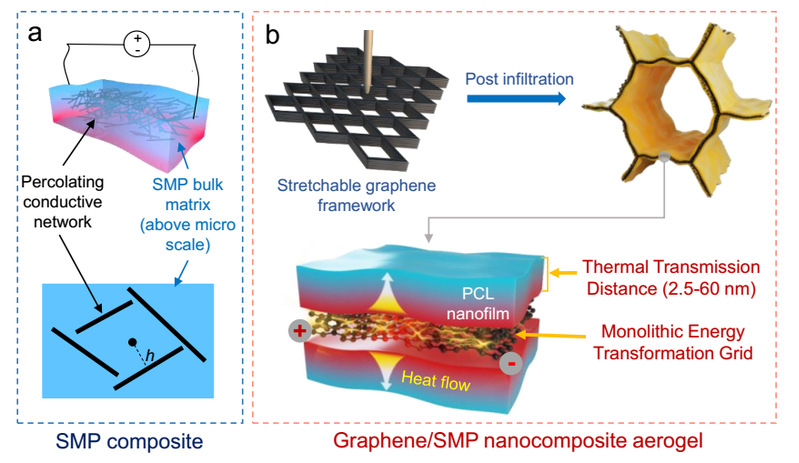Millisecond Response of Shape Memory Polymer Nanocomposite Aerogel Powered by Stretchable Graphene Framework
Time: 2019-05-13 visit times :10
Millisecond Response of Shape Memory Polymer Nanocomposite Aerogel Powered by Stretchable Graphene Framework
Shape memory polymers (SMPs) change shapes as-designed through altering the chain segment movement by external stimuli, promising wide uses in actuator, sensor, drug delivery, deployable devices. However, the recovery speed of SMPs is still far slower than the benchmark shape memory alloys (SMAs), originating from their intrinsic poor heat transport and retarded viscoelasticity of polymer chains. In this work, monolithic nanocomposite aerogels composed of bi-continuous graphene and SMP networks are designed to promote the recovery time of SMP composites to a record value of 50 milliseconds, comparable to SMA case. The integration of stretchable graphene framework as fast energy transformation grid with ultrathin polycaprolactone (PCL) nanofilms (tunable in 2.5-60 nm) enables the rapid phase transition of SMP under electrical stimulation. The graphene-SMP nanocomposite aerogels, with density of ~10 mg cm-3, exhibit fast response (175±40 mm s-1), large deformation (~100%) and wide response bandwidth (0.1~20 Hz). The ultrafast response of SMP nanocomposite aerogels confers extensive uses in sensitive fuses, micro-oscillators, artificial muscles, actuators and soft robotics. The design of bi-continuous ultralight aerogel can be extended to fabricate multifunctional and multi-responsive hybrid materials and devices. The work was published on the ACS Nano under the title “Millisecond Response of Shape Memory Polymer Nanocomposite Aerogel Powered by Stretchable Graphene Framework”.
Figure 1. Schematic illustration of conventional electric response SMP composite and nanocomposite aerogel
Conventional electric response SMP composite composed of percolating conductive network and SMP bulk matrix. The heat transmission distance (h) is micro to millimeter scale. The monolithic graphene framework serves as an integral energy transformation grid for fast thermal generating and injecting. The PCL nano-coating possesses uniform thickness ranging from 2.5 nm to 60 nm and therefore extremely short energy transmission distance (h), accelerating the phase transition of PCL. Consequently, the response speed of nanocomposite aerogels can be improved by about orders of magnitude, outperforming bulk SMP composites with percolating conductive networks and much larger h.
Figure 2. a-e,Digital photograph and SEM image of G-SMP nanocomposite aerogel with density of ~10 mg cm-3.
In this work, the researchers picked stretchable graphene frameworks with programmed truss structure as the efficient power network, which were fabricated by ion-aided gel 3D printing, followed by freeze drying and heat annealing (Highly Stretchable Carbon Aerogels Nat. Commun. 2018, 9, 881). The graphene frameworks have low density, only of 8 mg cm-3, yet possess large tensile strain (~100%), high electrical conductivity (~1100 S m-1) and thermal conductivity (~ 3.6 W m-1 K-1)。
Figure 3. a) The images of G-SMP nanocomposite aerogel with 0.35 PCL (α) under 4 V during shape recovery process. b) The tendency of length changes of G-SMP nanocomposite aerogel versus time under 4 V du ring one typical shape recovery process. c) Comparison of maximum actuation frequency (1/τ) and maximum deformation strain (tensile/compression) of G-SMP nanocomposite aerogel with various SMPs and SMAs.
The electric-triggered responsive behavior of single hybrid flake was tracked by in-situ transmission electron microscope (Figure 4). Following the same procedure in G-SMP monoliths, the hybrid sheet transformed as programed from an extended shape (permanent shape in Figure 4) into a scroll under the together action of compression force and applied voltage by a gold probe, and eventually maintained this temporary shape after releasing the probe. Once contacting with the biased probe, the fast generated Joule heat turned PCL into viscous state and drove the scrolled sheet recover to the permanent extended shape.
Figure 4. In-situ TEM observation of a single hybrid flake in one deformation-retraction cycle.
This G-SMP nanocomposite aerogels with millisecond response can be applied as a high-speed fuse to protect circuit elements from current overloading. The fast responsiveness merit allows G-SMP nanocomposite aerogels to couple with a high frequency electromagnetic field and work as a micro SMP oscillator.
Figure 5. (a) High-speed fuse of G-SMP nanocomposite. (b) Illustration of the high speed G-SMP oscillator
Professor of Department of Polymer Science and Engineering including Chao Gao, Zhen Xu, Lie Ma as co-newsletter author .This work is supported by Lie Ma, Hong Tao Wang(Zhejiang University)and Andreas Greiner, Seema Agarwal (University of Bayreuth) .

Written by Fan Guo
Zhe Da Road 38, Hangzhou 310027, China
Tel : 86-571-87951308
Fax : 86-571-87951592
Email : ciciliu33@zju.edu.cn